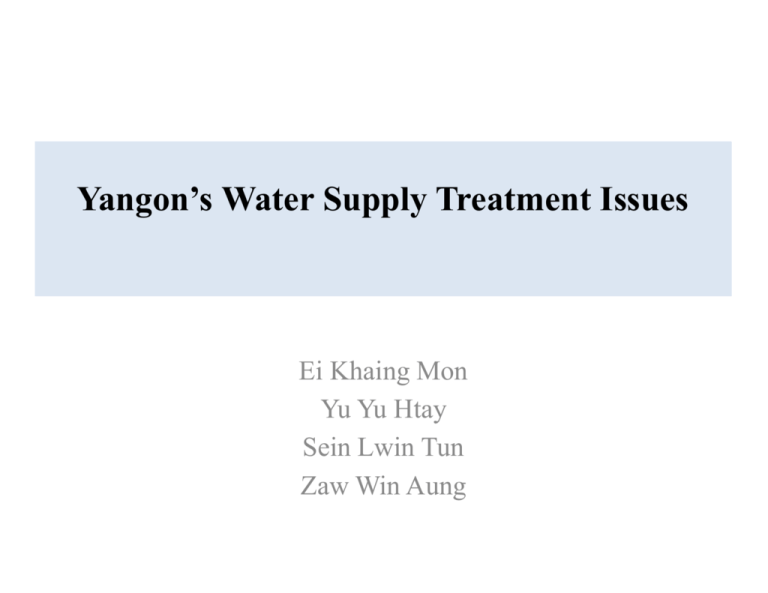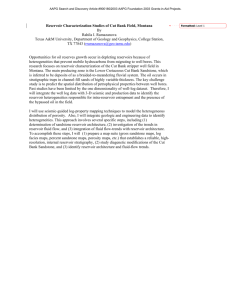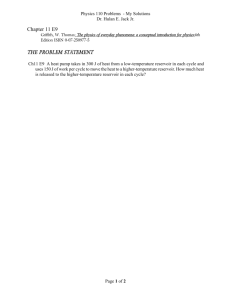Exercise 2_Yangon Water Supply Treatment
advertisement

Yangon’s Water Supply Treatment Issues Ei Khaing Mon Yu Yu Htay Sein Lwin Tun Zaw Win Aung Contents Overview of Yangon City Water Supply System Problems & Challenges Group’s Proposal Co-operate Request 2 Overview of Yangon City Water Supply System 3 Yangon City Water Supply System Water Resources And Transmission System of Yangon Gyobyu Reservoir 1842 Dug Well (30) 1879 Kandawgyi lake (stop using) 1884 Inya lake (stop using) Gyobyu Ngamoeyeik Ngamoeyeik Reservoir Phyugyi Phugyi Reservoir 1904 Hlawga Reservoir 1940 Gyobyu Reservoir Naunghnapin 1992 Phugyi Reservoir 1995 Ngamoeyeik Reservoir 2005 Ngamoeyeik WTP (1st Phase) 2014 Ngamoeyeik WTP (2nd Phase) Hlawga Reservoir Hlawga Thaephyu Yangonpauk 4 Data of Four Main Reservoirs Hlawga Reservoir Gyobyu Reservoir Phugyi Reservoir Ngamoeyeik Reservoir 5 WATER SUPPLY AMOUNT FOR YANGON CITY Available DAILY Water Resources & Water Supply Amount Surface water Gyobyu, Phugyi, Hlawga, Ngamoeyeik Reservoirs Ground water 442 Tube Wells operated by YCDC Lakes and ponds Existing 261 nos., used 108 nos. in 12 townships Daily Water Supply Amounts in Yangon City Gyobyu Reservoir - 27 MGD (122727 m³/day ) Phugyi Reservoir - 54 MGD (245454 m³/day ) Hlawga Reservoir - 14 MGD (63637 m³/day ) Ngamoeyeik Reservoir (1st Phase) - 45 MGD (204545 m³/day ) Ngamoeyeik Reservoir (2nd Phase) - 45 MGD (204545 m³/day ) Y.C.D.C Owned Tube Wells - 20 MGD (90910 m³/day ) Total 205 MGD (931,818 m³/day) 6 Ngamoeyeik Water Treatment Plant Pump station Inlet flow Flocculator Sedimentation tank Low lift pumps Water tower Rapid sand filter Outlet flow Clear water tank Open channel Intake reservoir Low lift pumps Water tower Sedimentation tank Rapid sand filter Clear water tank Pump station 7 Ground Water Treatment Using Aeration Method Aeration unit Pump house Sedimentation & filtration unit Clear water tank Pump House Tube well 8 Problems & Challenges 9 Major problems facing in Yangon City Water Supply System Technical problems Organizational problems Institutional problems Financial Management problems (1) (2) (3) (4) (5) (6) (1) (2) (3) (4) (5) (6) (1) (2) (3) (4) (5) (1) (2) (3) (4) (5) Low demand coverage High non-revenue water amount Poor treated water quality Ageing water facilities and main pipelines Inappropriate layout of facilities Insufficient O&M facilities Lack of planning section Lack of monitoring section Lack of O&M and management Poor awareness for customer services Poor water quality monitoring system Poor human resources development in the organization Standards for installation of service connections Standards for water meter Standards for installation of individual storage tank Standards for installation of individual pumping facilities Inspection of installation works for service pipe Cheap water price Water pricing system Need for introducing corporate accounting system Budget with little freedom Computerization in limited services 10 Major Challenges 1. Aged pipe lines (>100 year) and pumping stations 2. Direct injection of groundwater into the surface water distribution network at low pressure area 3. Unadequate and unequalized water pressure 4. Higher population growth 5. Rapid expansion of new satellite townships 6. Industrial and commercial development 7. Increasing water demand 8. Customer complaints for both water quality & quantity 9. High NRW % Group’s Proposal 12 Group’s Proposal • Capacity building for O & M of water treatment process and water quality monitoring • Rehabilitation the existing water treatment processes such as post chlorination facilities, disinfection facilities • Implementing continuous water quality monitoring system, for example, Supervisory Control and Data Acquisition (SCADA) system • Introducing the new sustainable water resources for ceasing the underground water consumption 13 Cooperate Request 14 Cooperation Request • Capacity building for engineers and staffs form our departments with the help of international organizations concerning about the treatment technologies, advanced methods and techniques 15 THANK YOU FOR YOUR ATTENTION 16 Year 17 2040 2030 2020 2010 2000 1990 1980 1970 1960 1950 1940 1930 1920 1910 1900 1890 1880 1870 1860 1850 1840 1830 1820 1810 1800 Population (million) Past and Future Population Trend of Yangon City (1800-2040) 11 Past data 10 Estimated data 9 8 7 6 5 4 3 2 1 0 Yangon City Water Supply System Gyobyu Reservoir Service level target of YCWSS Supply Sources Hlawga Reservoir (1904) 14MGD Performance Indicators Gyobyu Reservoir (1940) 27MGD Phugyi Reservoir (1992) 54MGD Ngamoeyeik Reservoir (2005) 45MGD (1st Phase) Groundwater sources Total supply capacity (2013) Ngamoeyeik Target Year Reservoir 2013 2025 2040 Non-revenue water (%) 66 35 15 Leakage rate (%) 50 25 10 Demand coverage (%) 35 60 80 20MGD Water consumption (gpcd) 30 35 40 160MGD Supply Pressure (bar) 0.75 > 1.5 Supply duration (hour) 8hrs. 24hrs. Water quality Non-drinkable Drinkable Demand Site (Yangon City) Population 5.14 million (2013) Daily water use 30 gpcd (imp. gallons/cap/day) Phugyi Reservoir OngoingHlawga and Proposed Future Projects of YCWSS Reservoir Daily water demand 154MGD Project Supply capacity & Start-up year Connections Ngamoeyeik 2nd Phase 45MGD (’14) 269,268 connections (2013) 90%(domestic), 8%(commercial), 1% (departmental), 1%(FOC) Lagunpyin Reservoir Demand coverage approx. 30% (2013) Non-revenue water approx. 66% (2013) Pricing System Fixed price per unit Water Price 0.11 USD per m3 (commercial) 0.08 USD per m3 ( domestic) 40MGD (’15) Kokkowa River 15MGD (’20) + 45 MGD (’25) + (240MGD) 60MGD (’30) + 120MGD (’40) Toe River 15MGD (’25) + 15MGD (’30) + Source: YCDC & JICA (180MGD) 30MGD (’35) + 120MGD (’40) 18 River Source: 1. Kokkowa River 2. Toe River WTP: 1. Gyobyu 2. Nyaughnapin 1 & 2 3. Lagunpyin 4. Kokkowa 5. Toe Ground water: 0 in 2040 19





